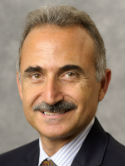Hereditary breast cancer: Prophylactic mastectomy, breast conservation, and rates of cancer Book Section
| Authors: | Walsh, S. M.; Robson, M. E.; Sacchini, V. S. |
| Editors: | Urban, C.; Rietjens, M.; El-Tamer, M.; Sacchini, V. S. |
| Article/Chapter Title: | Hereditary breast cancer: Prophylactic mastectomy, breast conservation, and rates of cancer |
| Abstract: | Hereditary breast cancers represent 5–10% of all breast cancer diagnoses [1] and up to 40% of all breast cancer diagnosed in women 35 years of age or younger [2]. In 1886 the French physician Paul Broca first noticed and described a familial clustering of breast cancer [3]; in his wife’s family, 10 out of 24 women, spread across four generations, reportedly died from breast cancer. In addition, several other family members died from other malignant diseases. Broca astutely concluded that this high incidence of cancer in a single family was too high to be attributed to chance. In 1990, p53 mutations were identified in Li-Fraumeni syndrome, a disorder with a high predilection for breast cancer [4, 5]. Subsequently, in 1994, using positional cloning methods, a strong candidate for the 17-q-linked BRCA1 gene was identified [6]. Probable predisposing mutations detected included an 11-base pair deletion, a 1-base pair insertion, a stop codon, a missense substitution, and an inferred regulatory mutation. The BRCA1 gene was found to be expressed in numerous tissues including the breast and ovary. In 1994 Wooster et al. [7] performed a genomic linkage search with 15 high-risk breast cancer families that were unlinked to the BRCA1 locus on chromosome 17q21 and were successful in localizing a second breast cancer susceptibility locus, BRCA2, to chromosome 13q12–13. In 1995, in a collaborative effort between the University of Utah and the Institute of Cancer Research in the United Kingdom, a set of families with a predisposition to breast and ovarian cancers were studied and reliably excluded from linkage to BRCA1 lead to the landmark discovery of the second breast cancer gene, BRCA2 [8]. © Springer International Publishing AG, part of Springer Nature 2013, 2019 |
| Book Title: | Oncoplastic and Reconstructive Breast Surgery. 2nd ed |
| ISBN: | 978-3-319-62925-4 |
| Publisher: | Springer |
| Publication Place: | Cham, Switzerland |
| Date Published: | 2019-01-01 |
| Start Page: | 33 |
| End Page: | 42 |
| Language: | English |
| DOI: | 10.1007/978-3-319-62927-8_4 |
| PROVIDER: | scopus |
| DOI/URL: | |
| Notes: | Book chapter: 4 -- This chapter can be found under "Part I Basic Principles for Oncoplastic and Reconstructive Breast Surgery" -- Source: Scopus |
Altmetric
Citation Impact
BMJ Impact Analytics
Related MSK Work






